How I Spent My Time During the Coronavirus Pandemic
I remember talking with my mom a few years ago, confidently telling her that if I were to suddenly became less mobile for reasons of money or health, I’d still be able to get my “travel fix” and that there would be no way I’d become bored.
“In this day and age with the Internet,” I said, “you can totally experience the world virtually. There are millions of videos about other places, you can do flyovers via Google Earth, and you can even communicate with people around the world on Skype.”
My mom, not being the enthusiast of “real” travel that my dad and I are, agreed. In fact, in February after a trip to Costa Rica that she and my dad cut short because they “aren’t interested in just seeing nature,” she said that “I told your father ‘no more traveling now.’ If I want to see another country, I’ll watch YouTube.”
Ironically, a few weeks later, the World Health Organization declared COVID-19 to be a pandemic, and I had gotten in one last out-of-state marathon and weekend vacation in Asheville less than a week before the nation started to lock down. Not only was going out of town ill-advised, but so was leaving home. Now was the time to see whether what I had boasted to my mom was true or not.
A few months later, I can comfortably say that while I did not take nearly full advantage of the opportunities that being home full-time affords, I was indeed never bored out of my mind. Nor would I say I was entirely unproductive, even if I feel like I should have been able to do, say, two-thirds of yet another graduate degree during that time.
Below is a look back at some of the ways I spent those three months. This is a really unique period of time we live in, so documenting it for posterity seemed like a must.
For the first time ever, I began to stockpile
I’ve never been one to hoard. Partly because of my minimalist and simplicity proclivities and my engineer-ish tendencies to optimize, my philosophy towards keeping inventory is similar to that of a Toyota factory that preaches just-in-time manufacturing. Pair all that to having a real distaste for waste and clutter that teeters close to a clinically confirmed phobia, and it makes sense why for eight whole years until 2013, there was a refrigerator/freezer combo measuring a mere 4.3 cubic feet in my kitchen that I fondly dubbed “the bachelor fridge.” Anything larger seemed unnecessary and wasteful.

But I have been trying to develop more of an abundance mindset over the years. So when the state of emergency for COVID-19 was announced, it was jarring to realize that here in the good ol’ USA, there were going to be some shortages of things.
This fully hit me when, on March 13th, I decided that I better buy at least a couple weeks’ worth of food in case as a lockdown seemed inevitable, went to King Soopers, and noticed shelves like these:

That day, I ended up buying $200 worth of food and stood in a check-out line over 20 people deep for nearly an hour. All those groceries barely fit in the trunk of my Audi TT Roadster.
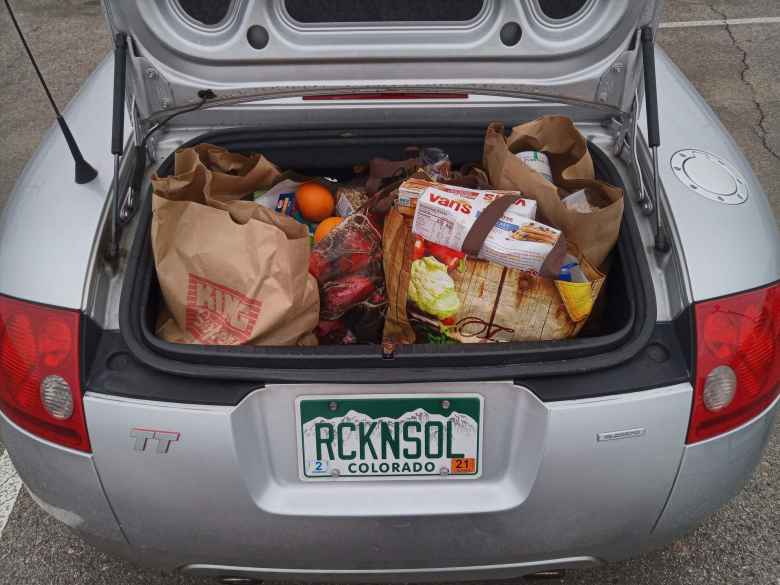
It was also the last time I’d be able to use reusable bags, and after that, my new year’s resolution to minimize plastic waste was tossed into the recycle bin, so to speak. In the months after, I would go on and place online grocery orders with curbside pickup only twice a month, and while I fully appreciated the American heroes who did the grocery shopping for me, with every order came about 50 disposable plastic bags.
Meanwhile, the pantries, freezer, and full-sized refrigerator have been well-enough stocked that I should be able to survive a three-week period of not being able to get groceries, if need be. That unlikely but imaginable scenario brings me to the next section.
I started to garden (sort of)
I have a large garden plot which, hilariously, was even pictured in a book. But that doesn’t mean that I’ve ever liked to plant things. Gardening can take a lot of time, and you could argue I have way too many hobbies already.
But with the current crisis, I started to see the wisdom in being more self-sufficient. Or at least having that ability. So I decided to do a small-scale test. Could I successfully grow vegetables if I had to?
As you can see from the photo below depicting vegetables grown from seed and regenerated from the roots of store-bought green onions, the answer is YES!

Of course, the above is only good for five calories. In a true food crisis, I would need to grow way more vegetables than that.
Then came the March and April showers, and all these yellow flowers were growing in my back yard. Dandelions. Lots of them.

I once heard that you can make salads from them. I decided to give it a shot.
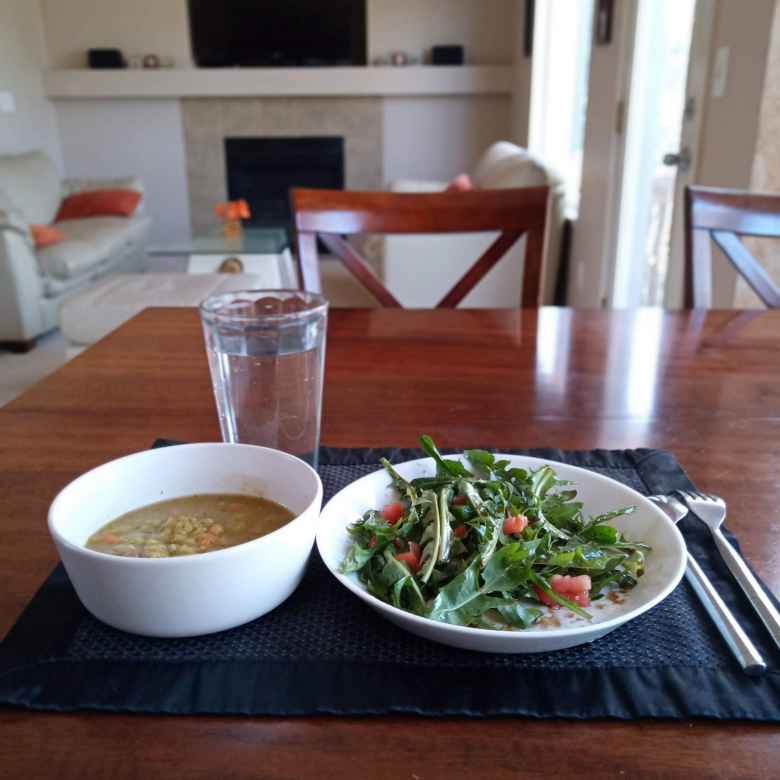
Not bad, I concluded. A bit bitter, but not much worse than your typical spring greens mix. If I ran out of vegetables, I could definitely eat these without complaint. And they took zero effort to grow.
Cooking!
Like everyone during the coronavirus, I busted out the pots and pans a lot more. The last time I went out to eat was on March 12, when Katia invited me out for Great Plates and wine downtown. Since then, I still haven’t eaten out—not even for take-out.
Instead, the Instant Pot went on duty several times a day. This life-changing pressure cooker has saved me huge amounts of time. Normally, it requires only 30 seconds of dumping one or two ingredients in with water, locking its lid, pushing a few buttons, and voilà. Food cooks fast and no babysitting is required; just walk away and return after it’s done.
It also has a timer function so you can, for example, put steel-cut oats in it before you go to sleep, have it start cooking an hour before you wake up, and have breakfast awaiting when you do.
Some of my most-used “recipes” include the following:
- Brown rice: 1:1.25 rice-to-water ratio; cook for 8-12 minutes
- Quinoa: 1:1.1 quinoa-to-water ratio; cook for 1 minute
- Beans and legumes: pour in with water so that the water line is about a half-inch or so above the beans, and cook for 20-40 minutes, depending on how soft you want the beans. I have cooked garbanzo, black, red, and pinto beans this way.
- Steel-cut oatmeal: 1-3.5 oats-to-water ratio; cook for 8 minutes
- Pasta: pour in with water so that water line is about a half-inch above; cook for 3 minutes or maybe less for al dente.
In addition, for the first time, during the coronavirus I have made the following using the Instant Pot:
- Bone broth: Save chicken bones, e.g., from a rotisserie chicken, and keep them in the freezer until you are ready to make bone broth. Once you have a good amount, dump them in the Instant Pot along with optional vegetables like onions and garlic and carrots, and fill to the max water line (usually about two-thirds of the pot). Then cook for three hours using the Soup/broth function.
Tip: you can make at least two batches with the same set of bones.
Second tip: Per the book Play On: The New Science of Elite Performance at Any Age, gelatin, including bone broth, is great for maintaining or improving joint health. It said that the late Kobe Bryant had a chef make bone broth for him every night during the last few years of his NBA career to help his ailing knees. - Sweet potatoes: cut in half lengthwise and place on steel wire rack that came with Instant Pot along with a cup of water, and cook for 8 minutes.
- Mashed potatoes: cook the same way as sweet potatoes above, and mash with fork afterwards.
I prepare most hot meals with the Instant Pot or microwave, but have also done “real” cooking once in a while during the coronavirus.
For example, I like Mexican food, but there must have been a run on tortillas because every time I placed an order for one from King Soopers, they had none. Meanwhile, I had a whole bag of instant corn masa flour from making pupusas.
So ultimately, I ordered an inexpensive, but made-in-the-USA tortilla press off of eBay, and started making homemade tortillas.
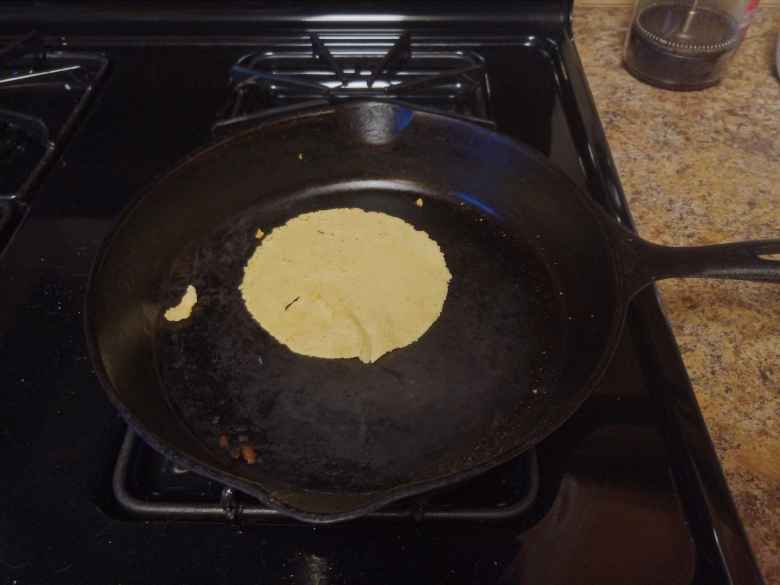
This resulted in a delicious dinner with enchiladas:
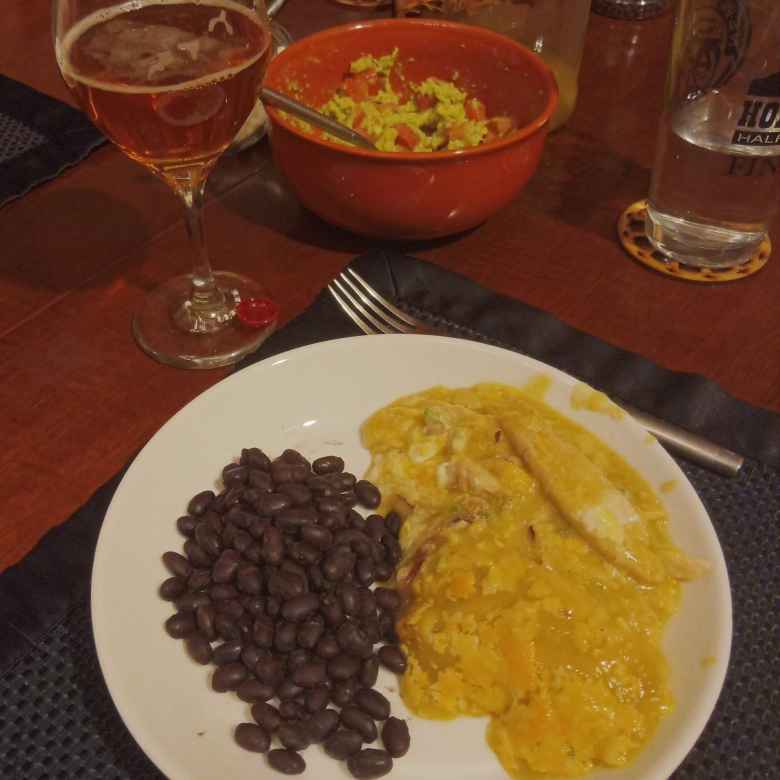
While they tasted good and reminded me of getting daily fresh-made tortillas in Guatemala while volunteering at Maya Pedal, I think I’ll go back to buying tortillas from the market when they are back in stock. A whole lot less work.
I also baked a whole chicken for the first time ever:
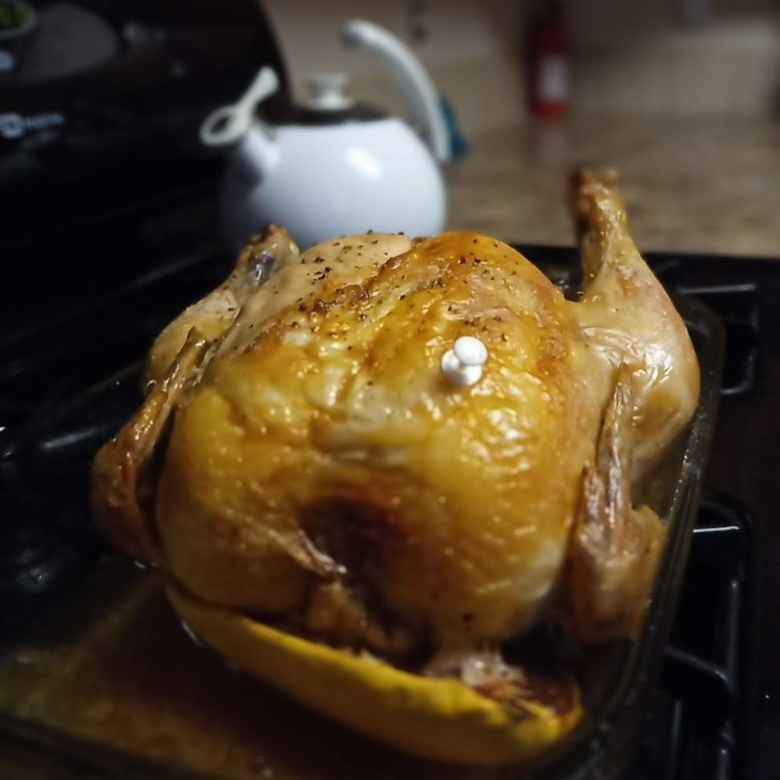
But like with the tortillas, I think I’d just buy a cooked rotisserie chicken from the store instead going forward. About the same price per pound and much less preparation time.
Zoom Zoom
One of the first things I did in confinement was to purchase a monthly Zoom subscription to host virtual meetings longer than 40 minutes. Considering how many times I use it each week, it has been well worth it.
For example, I moved all Spanish, French, and Mandarin Chinese Conversation meetings to online only. This came with unexpected benefits:
- Former members of the conversation groups who had moved away could join our meetings once again. It was so good to see friends like Antxon, Azad, David, Melanie, Sam, and Vicky who live out of state or in another country. We once had a meeting where Spanish speakers from five different time zones joined in on the teleconference.
- It was often easier to share web links and new vocabulary words with the whole group. Just paste in the chat window.
- Likewise, it was easier to save the vocabulary words. Just save the chat!
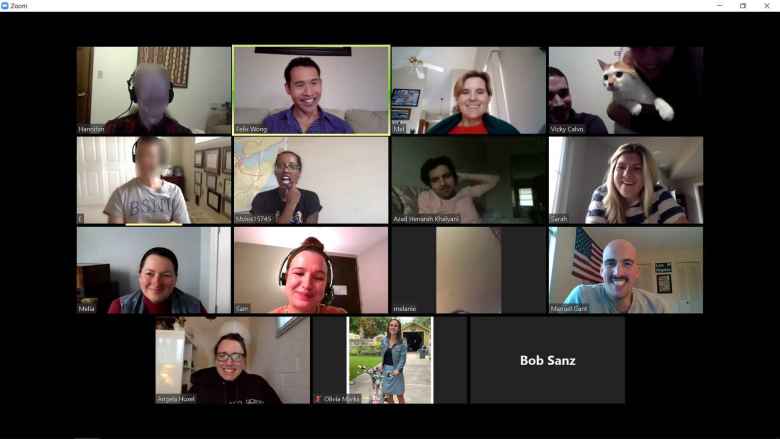
I became more serious about studying foreign languages
Being in confinement seemed a natural fit for studying something. One thing I decided early on was that I would put more emphasis on becoming more fluent in foreign languages.
To that end, I started doing Duolingo daily. I made it a goal to finish the French skills tree (again), and once I finished that, I resumed doing French and Portuguese exercises on Duolingo.
Secondly, on some runs and while doing yard work, I listened to Pimsleur Mandarin lessons. I want to finish all 30 Pimsleur Mandarin IV lessons by summer’s end.
Thirdly, I reviewed vocabulary (Spanish, French, and Mandarin) daily using Quizlet. One exciting feature of Quizlet I only recently “discovered” was a play button that makes it reads both sides of the flashcards out loud continuously. This has enabled me to review flashcards while cooking or brushing my teeth, for example.
Fourthly, I started labeling household items in Spanish, French, Mandarin, and Portuguese.
Fifthly, I tried reading at least half of the news each day in Spanish or French. The Microsoft News app—an aggregator of news from reputable sources around the world—is particularly good for that as it has about 60 different editions specific to various regions in the world. You can easily change the country and language in its settings, and the free app is available on both PCs and smartphones.
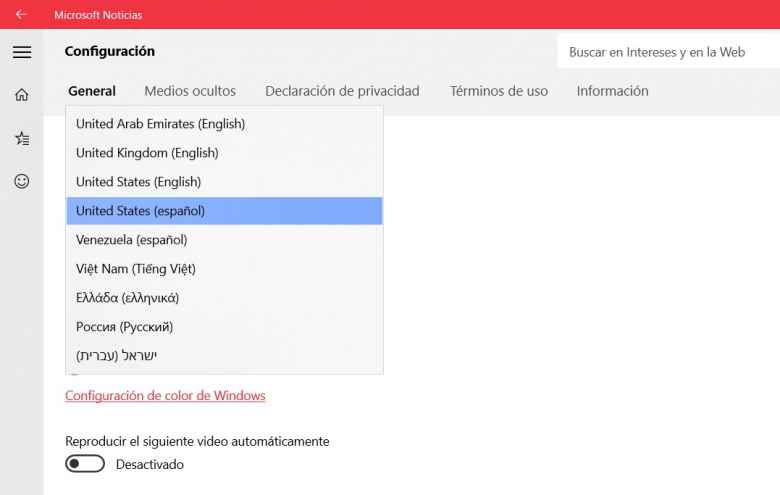
Finally, I started using a language exchange app called HelloTalk where you can chat with other language enthusiasts all around the world. I love HelloTalk not just for the social and cultural aspect, but because of its transcription, translation, and correction tools.
For example, native speakers can correct mistakes in my grammar, which I highly appreciate as it is one of the best ways to learn. Shown below are some of the corrections that I saved to review from time to time.
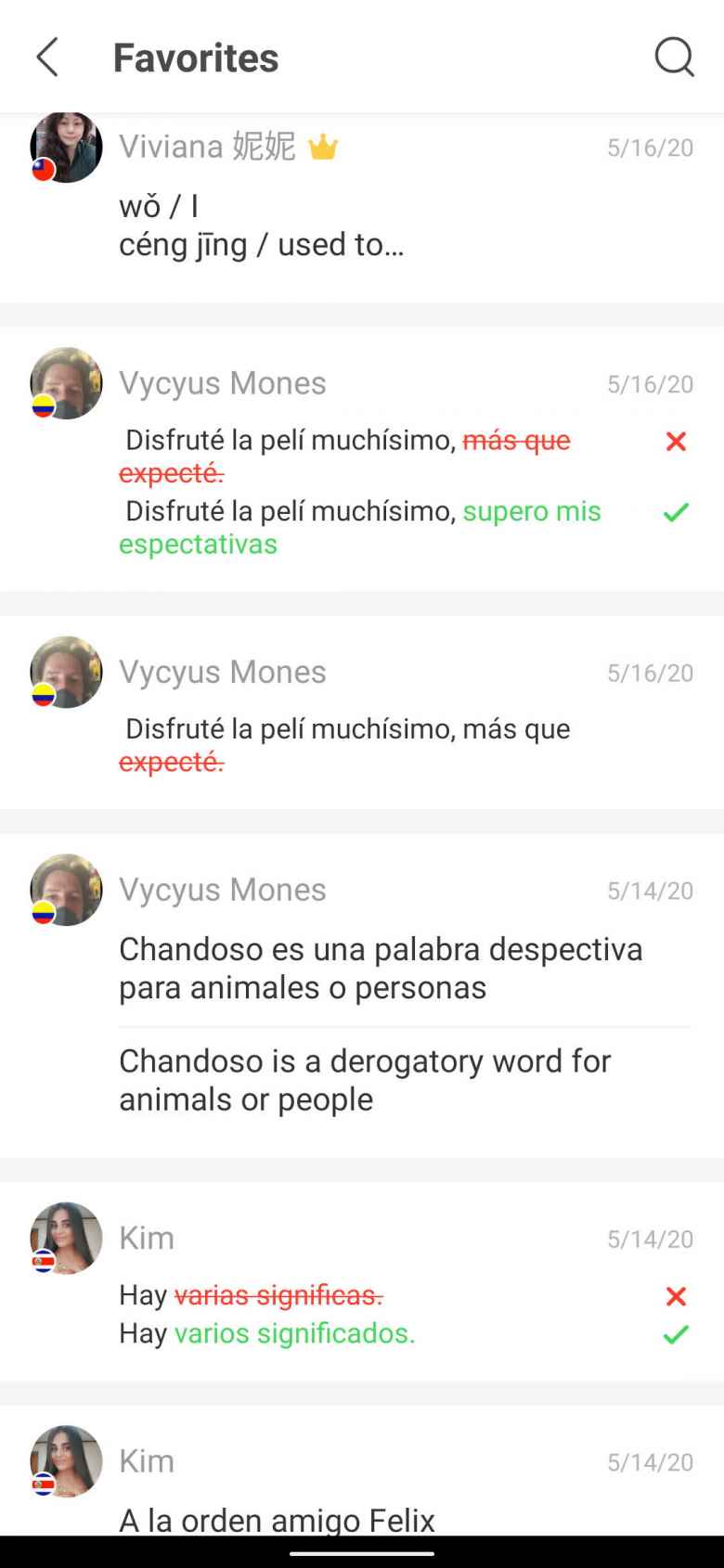
I’ve enjoyed HelloTalk so much that I even purchased a $30 annual subscription, which supports searching for language partners in up to three different languages, and unlimited use of the transcription and translation tools. It has also become one of my primary social outlets; at any time I feel like it, I can pick up the smartphone and have someone to chat with. In fact, it can be so time consuming that I now limit myself to certain times of the day to use it, in order to get other things done.
Gratitude for the home gym
The last couple years I’ve been doing powerlifting, body pump, and yoga workouts in gyms and studios more than at home, mainly for the coaching and social aspects. Of course, all that changed with the coronavirus, and now I am super happy to have invested in a power rack and 285 pounds of weights back in 2006, shortly after buying my home.
One thing I started doing were hip thrusts, as inspired by my friend and powerlifting enthusiast, Niki. Here I am thrusting 185 pounds:
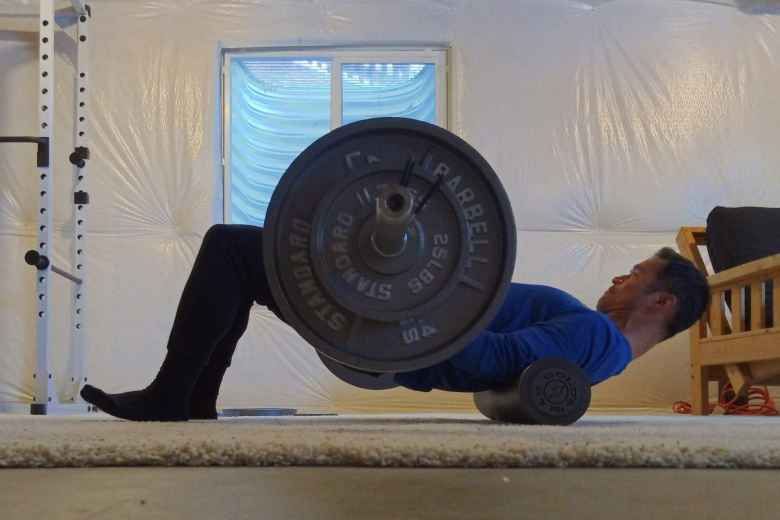
That was actually a lot of weight for me, but is nothing compared to Niki. She must have titanium glutes and hamstrings as she has been hip thrusting 605 pounds despite weighing under 140! I now regularly do sets of 225.
Another thing I have been doing more of is bicycling on the Reynolds Wishbone Recumbent on a stationary trainer in the basement, as it allows me to watch videos or read e-books at the same time.
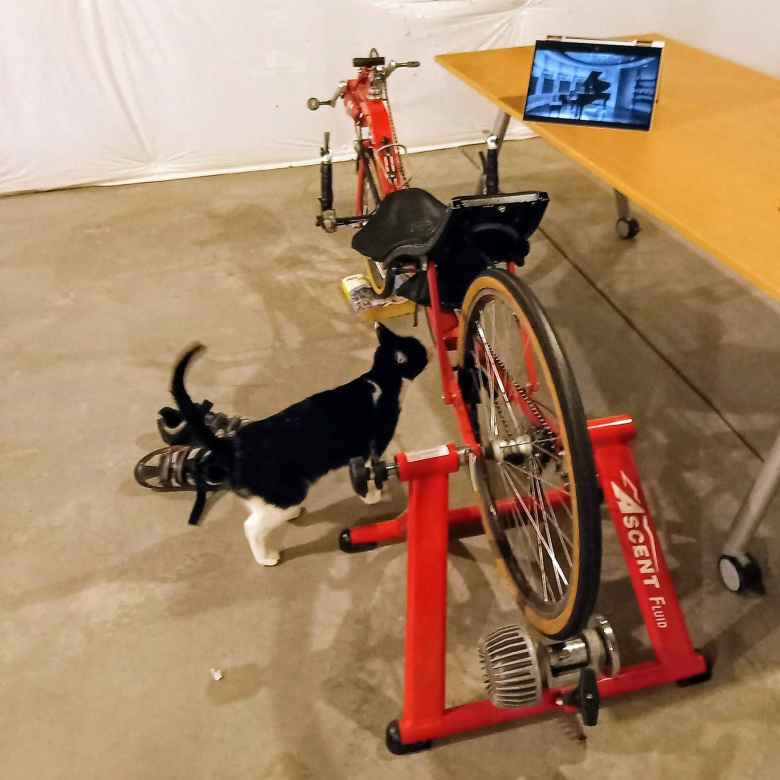
I drove a whole lot less
In contrast to bicycling, I’ve been behind a steering wheel of a motorized vehicle way less. As of this post, I’ve driven a total of five times since March 13, each time to do curbside grocery pickup. It is interesting to compare my cycling, running, and driving totals from March 14 to May 31, or 78 days or about 11 weeks:
Bicycling: 1239 miles
Running: 163 miles
Driving: 40 miles (including motorcycle)
I definitely feel like I could live without a car now. If I didn’t like cars so much, that is a significant expense that could be potentially eliminated.
I stretched my hamstrings for 60 seconds a day
I’ve never been good about stretching and have lost a bit of flexibility over the years. Doing hot yoga somewhat regularly earlier in the year probably helped some, but with the coronavirus and studios closed, that ceased to be an option. Now and then I might follow a 5-minute yoga video on YouTube, but have yet to make that into a regular habit.
But then I saw this 8 Week Flexibility Challenge video around the beginning of April. This inspired me to stretch my hamstrings for at least one minute everyday.
This entailed sitting on the floor with legs straight out in front and reaching the fingertips towards to toes after starting the timer on the Garmin. Per the tips in the comments of the said video, I tried to stay relaxed while taking deep breaths.
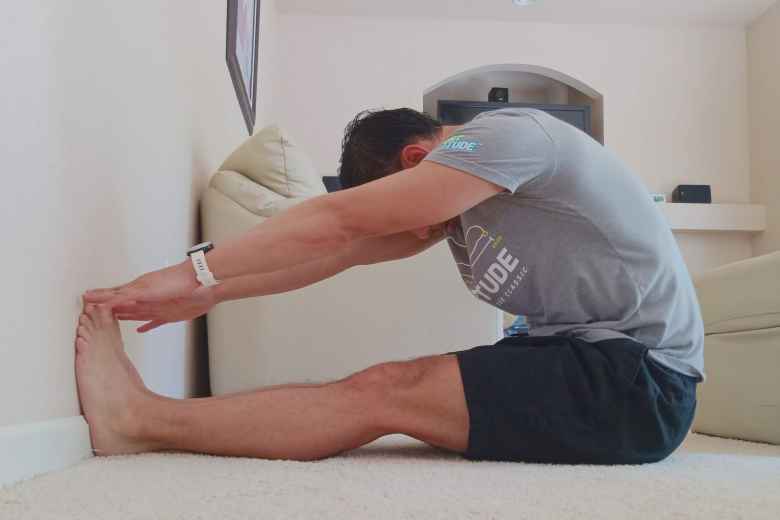
After two months, I think I gained 1-2 inches of range, which was not very much compared to the guy in the video who achieved an 8″ increase. But I never was as inflexible as him, having been able to touch my toes before starting the stretching habit. And since it only took 60 seconds a day, I’m pretty happy with gaining anything.
Which begs the question: what other things can we improve on with a mere minute of effort each day?
I read more
One of my resolutions was to read more books and waste spend less time perusing news and social media.
I regressed big time about reading news due to wanting updates on the coronavirus situation, but have indeed been spending a lot less time on Facebook and Instagram. And I have been reading more books.
One of the best things I have “discovered” this year was Hoopla, a digital media service that offers book loans. Like Overdrive, the public library’s other e-book loaning service, the loans are provided for up to 21 days. But unlike Overdrive, there does not seem to be a limited number of electronic copies circulating and you never have to place a hold on an offered title.
Hoopla also seems to have way more books that I am actually interested in, versus Overdrive. There are enough titles that I let my Scribd annual subscription expire and will read ebooks from Hoopla, and the occasional Kindle purchase, going forward.
I also read a lot of executive book summaries on ReadItFor.Me before my annual subscription expired.
Below are the books and summaries I have read in the last few months:
- Treating People Well
- Designing Your Life
- The Motive
- Best Self
- Leaders Eat Last
- Willpower
- Never Split the Difference
- The Progress Principle
- From Zero to One
- Factfulness
- Extreme Productivity
- Steve Jobs
- Talent is Overrated
- Choose Yourself
- Simply Brilliant
- The Miracle Morning
- The Perfect Day Formula
- Decisive
- Willpower Doesn’t Work
- Unshakeable
- Delivering Happiness
- Run for Life: The breakthrough plan for fast times, fewer injuries, and spectacular lifelong fitness
- The 10X Rule
- Finishing Basements
- The New Low Maintenance Garden
- Hotel Sweet Home
I cut my own hair
Because all barbershops were closed, I had to cut my own hair for the first time since when I was a poor college student.
It wasn’t particularly hard to do with a mirror and electric clippers. But while I would not say the results were a complete and utter disaster, I am definitely not proud enough of the results to post any photos here. Of all the services we take for granted, this is one I miss the most.
At least I was saving money on haircuts and gas!
I reviewed my finances
In recent years, I’ve turned down more and more outside engineering contract work, making financing my modest lifestyle more reliant on my investment portfolio.
Considering the S&P 500 dropped by 36% in a mere couple weeks in early March, this could have been problematic if my assets were not well diversified.
Fortunately, earlier last decade, I read Tony Robbins’ 600+ page masterpiece entitled Money: Master the Game, of which an entire section is devoted to the financial strategies of the world’s greatest investors such as Warren Buffett, Carl Icann, David Swensen, and more.
I became significantly more financially conservative after day-trading in my 20s, benefiting enormously from the dot-com boom and the housing bubble of the naughts, and then becoming financially independent/(semi-)retired early (FIRE) by age 30. So I adopted a financial strategy outlined by Ray Dalio and dubbed the All-Seasons Portfolio by Tony Robbins, who discusses it in depth in his book.
Robbins and his team of financial experts concluded that the All-Seasons Portfolio returned about as much as the S&P 500 over the last 100 years, all while avoiding the massive drawdowns the benchmark experienced. E.g., in 2008, when the S&P 500 lost 37% of its value between January and December, the All-Seasons Portfolio lost a mere 4%. It also experienced half the number of down years as the S&P 500, and significantly outperformed that benchmark during the “lost decade” between 1999-2009, when the index gained virtually nothing.
After 2008, the economy went on a historic bull run, so the recent public health and economic crisis was the first real test of the All-Seasons Portfolio for me, despite investing in that manner for most of the last decade.
In early March 2020, the S&P 500 was down by 36% compared to the beginning of the year. Meanwhile, I never noticed my portfolio being down by more than 10% year-to-date. No sweat. And since the stock market has somewhat recovered, my investments are actually up YTD whereas the S&P 500 is still down.
Backtesting the ETFs in my All-Seasons Portfolio as far as there was data for them (one of the ETFs did not exist before 2007), it appears that it has returned about as much as the S&P 500, but with one-third the volatility. This is exactly what Tony Robbins had claimed/predicted back when he wrote his book.
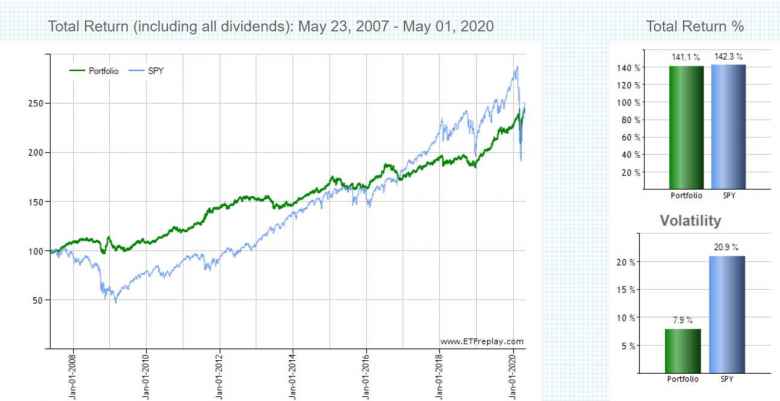
One benefit of the coronavirus is that my expenses have never been lower since college. There was nowhere to go and nothing to spend money on except for food. Low spending, coupled with good asset management, has meant that my net worth continued to increase through the crisis despite not receiving a single government stimulus check.
I customized some of my tech
Phone
I replaced my phone last October with the Bold N1, which has been an absolute delight to use. It has a full-screen OLED display with no bezels, notch, or hole-punch, due to its pop-up selfie camera; amazing battery life; a ton of storage; wireless charging; and fast and efficient processor. It’s also designed by an American company not at risk of being blacklisted by the U.S. government. The main thing I wished for were OS updates.
Enter the world of custom ROMs. I never had installed one before due to the risk of “bricking” the phone, but the Bold N1 cost an astoundingly low $200 brand new, mitigating potential consequences. I’m both a techie and a creative, so installing a custom ROM and taking full control of what is installed intrigued me.
The Bold N1’s bootloader was remarkably easy to unlock. From there, flashing a custom ROM was no harder than making ramen in the microwave. Some tips on how to flash a ROM onto a Bold N1 are in this article and this thread.
During the coronavirus, I installed AOSP Android 10.0 v.214, so I am running the latest version of Android now instead of factory-provided Android 9 (Pie). There’s no bloatware now; I was even able to remove some of the Google services I never use.
One thing I really like about Android since switching over from Windows Phone is how much you can customize it. E.g., hide the status bar, change the navigational gestures, use screen widgets and even install an entirely different launcher.
Lots of really creative themes other people designed are at Android Output’s Instagram page.
Being a Windows fan, I came up with the following minimalist theme inspired by Windows 10 and one of my favorite muscle cars, by using the excellent Square Home launcher.
Laptop
For the beautiful HP Spectre x360 laptop, I installed the “invisible laptop stand” made by MOFT, or “Mobile Office For Travelers.” This was a successful Kickstarter project and is an ingenious invention that makes laptop use much more enjoyable by elevating the screen. With it, you don’t need to crane your neck and can maintain much better posture.
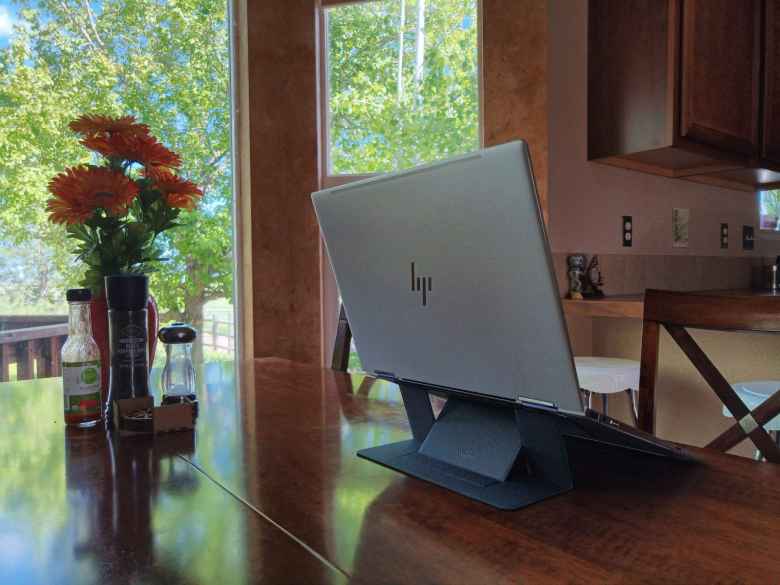
I love the MOFT laptop stand so much that I will probably devote a whole blog post to it in the future.
A few home projects
I finally got around to doing some low-priority house repairs that were on the to-do list for years.
One was repairing a window screen in the basement:
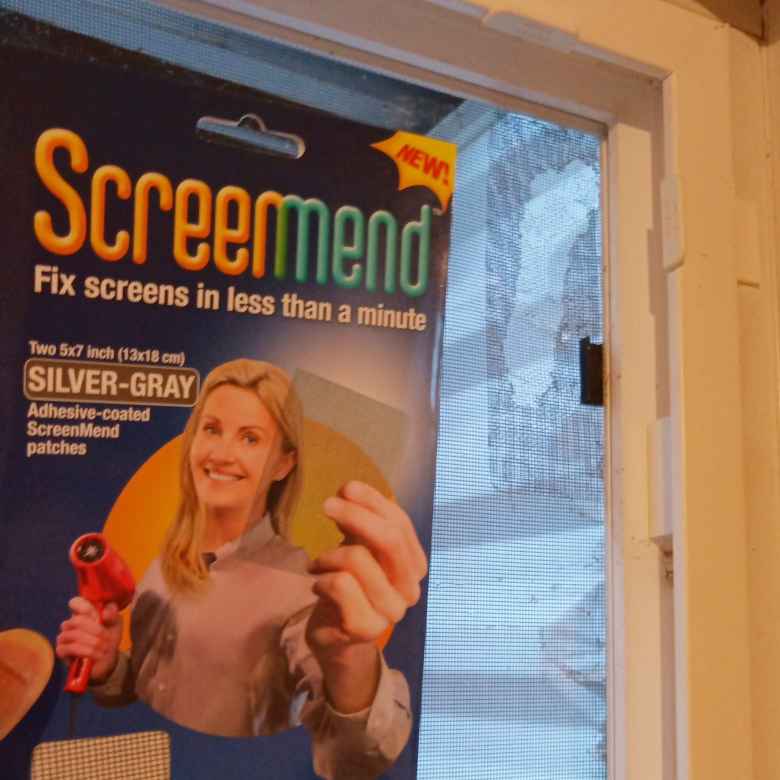
Regardless of what the packaging said, the repair took around 30 minutes instead of 60 seconds, particularly because the screen repair material’s paper backing would not cleanly separate from its adhesive. But the repair was a success and should keep bugs out.
Another fix was the carpet in the master bathroom. I bonded some of the ScreenMend material to the bottom of the carpet where it had thinned out, and then hot glued bits of carpet “threads” from other edges of the carpet to the corner shown. Basically, it was like a hair transplant.
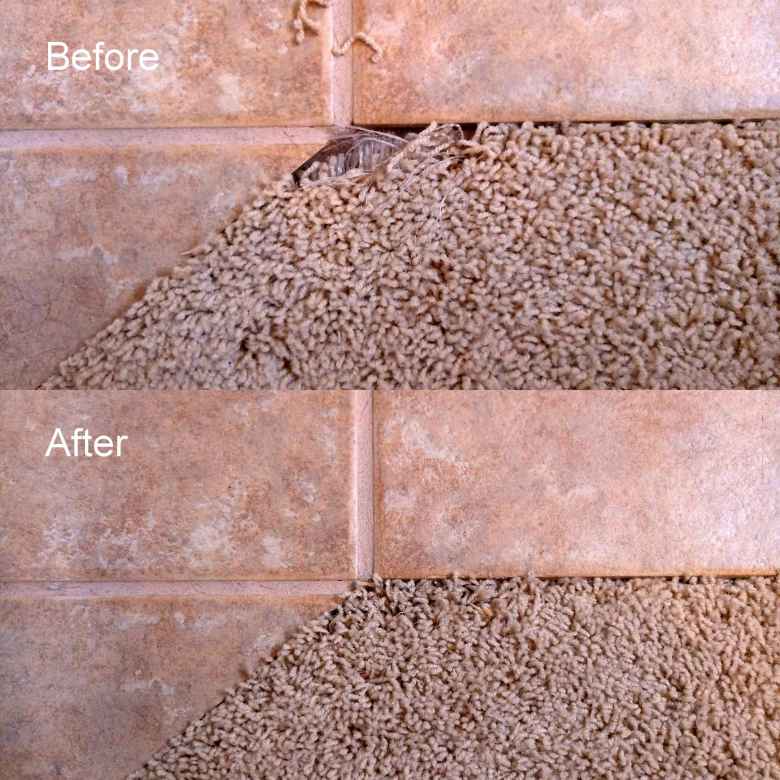
Looks a lot better, yes?
I also fixed the third-octave E key on the piano that would annoyingly stay depressed whenever the pedal was pressed. That was about an hour job.
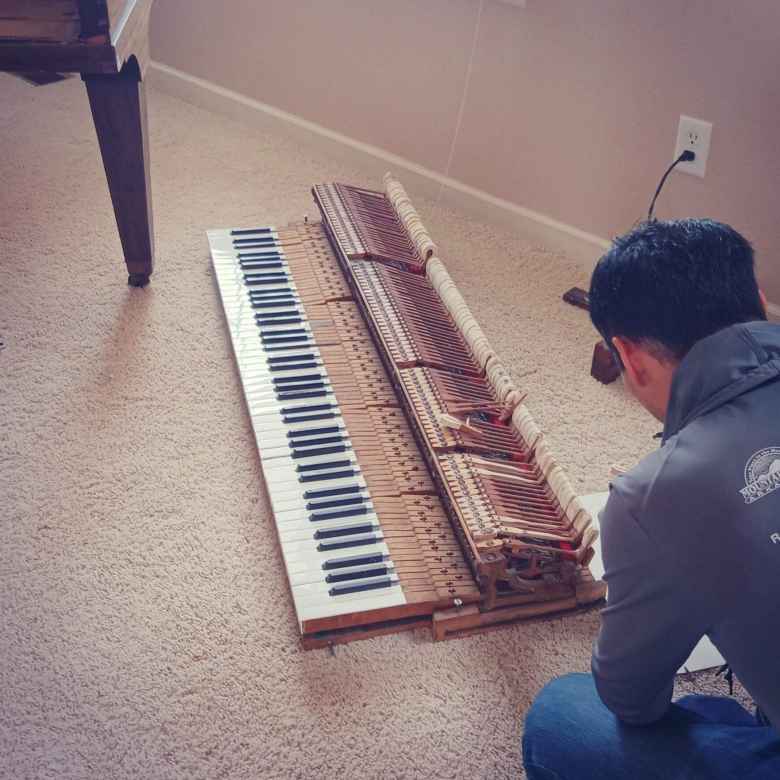
Virtual piano recitals
The main reason for fixing the piano is that I started playing again. I did my first virtual piano concert for Cohere, and then set a goal of doing one for at least five different songs. So far I have done four.

You can view the performances here. The fifth song I picked is taking much longer to learn and memorize than I hoped.
I watched more movies than ever
I’ve definitely watched more films in the last three months than in the last three years combined.
Some of my favorites were:
- Free Solo: An inspiring, fascinating, and amusing documentary about Alex Honnolds’ mind-blowing ascent of Yosemite’s El Capitan without rope or any protection.
- Enemy of the State: This Will Smith movie, made in 1998, is more relevant than ever with government surveillance being a big concern.
- The Big Short: A hilarious and educational movie about the housing and financial crisis of 2007-2008 that is >90% true.
- American Sniper
- The Karate Kid (1984)
- The Next Karate Kid (1994): Yes, the awfully rated one with Hilary Swank
- The Karate Kid (2010)
- Iron Man 2: Elon Musk and Scarlett Johansson are in it!
Going forward, I intend to watch more foreign language flicks on the public library’s free Kanopy system.
I learned how to use mindmapping software
Mindmapping is a way to visually organize hierarchical information. I like to do it while trying to solve problems and map out possibilities.
I used to do this freehand—either with pen and paper, or more recently, with stylus and convertible laptop touchscreen—but always wished there was more dedicated software for doing so than, say, Microsoft OneNote.
Enter FreeMind software. Not only is it open source and free, but it is brilliant and super easy to use. Inserting and moving nodes is quick and intuitive.
I used FreeMind to come up with ideas on how to spend my time during the coronavirus, and will be using it for a lot more mindmapping sessions going forward.
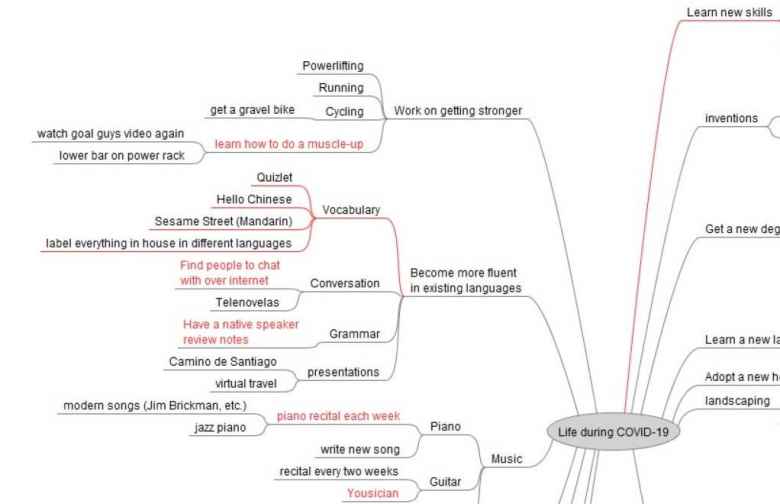
What’s next?
There’s still a lot of uncertainty regarding the coronavirus. As society begins to re-open in limited ways, it remains to be seen when we can go back to hugging and traveling freely again, or whether there is another wave of infections and movement becomes highly restricted again.
One quote came to mind when the coronavirus became a harsh reality:
Life isn’t about waiting for the storm to pass. It’s about learning to dance in the rain.
Vivian Greene
The coronavirus, I came to realize, was what Stanford professors Bill Burnett and Dave Evans—authors of the book Designing Your Life—would call a gravity problem. Its existence, like gravity, is something we cannot change—unless you are a vaccine developer, perhaps. So instead of constantly complaining about it or even blaming China, a better use of personal energy is to figure out what you can do to thrive even with viruses around. Or gravitational attraction.
As stated earlier, I don’t think I have taken advantage of the situation—and the fewer distractions isolation affords—as much as possible. But the “new reality” is continually evolving, and so can our actions.
It may be time for another mindmapping session to figure out what to do during the rest of the year and prepare for what may or may not happen. I’m looking forward to brainstorming with FreeMind again.
